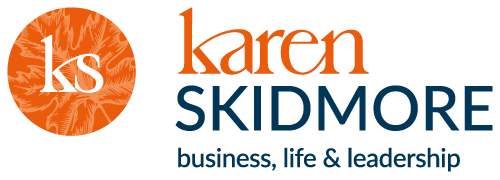
by Karen Skidmore | 06,19 | Marketing Articles, Stories, inspirations & thoughts for the day
Do you ever wonder if anyone is actually really and truly reading, listening or watching your content?
Today, all our content can be tracked by metrics; number of likes, comments, click-throughs and shares.
But do they tell the whole story?
I was out last night with a group of wonderful women who I’ve got to know quite deeply over the last couple of years. I’ve shared wine with them, lots of laughter and, at times, tears.
We got talking about my new book due out this September and I realised how many of them not only subscribed to my email updates but also read every email.
Now I do look at my email marketing metrics.
I can see that my average open rate right now is at 38.5%, which I know is high for my industry.
But I also know that open rates don’t tell me who actually reads my emails.
It’s one thing having a cookie sent back from their email server to mine that the email has been opened, but it’s another to know that the human being who signed up for my emails has actually read it. That would be a little bit creepy, yes? Having access to your camera on your phone to see if your eyes scan through the copy … too much ‘big brother’, thank you very much.
So to hear from several of the ladies last night that they read EVERY SINGLE email from me woke me up.
It gave me a much-needed reboot and reminder that the impact that we can make from the content we create cannot be measured by metrics alone.
It’s the same with our like counts on our social media accounts.
It’s easy to believe that a post with just one or two likes hasn’t done anything; it’s just slipped through the newsfeed and allowed the algorithm to swallow it up.
But this is simply not the case.
There are dozens, if not hundreds, of the ‘right’ people who will feel inspired by your content without reacting to it. They watch, listen and read without leaving any trace, such as a click or a tracking cookie (because more people are switching these off than ever before).
What does this mean to you and me?
Firstly, it is important to recognise that you are here to run a commercial business. If you produce content for entertainment value only or just create content for the sake of creating content (think robotic, automated sharing systems that do nothing but create white noise), you end up with an expensive hobby, rather than a purposeful, profitable business.
But the feedback that I had last night from my buddies, inspired me to see that the content we create can have a greater impact than our metrics tell us.
Whether I get an email from you or not (although a reply to one of my emails boosts me no end – seriously – that quick moment of recognition makes a real difference to me), I am reminded that not everyone has time nor knows what to say to show me that they’ve read, watched or heard my content.
It’s the same for you, too.
If you ever find yourself wondering if anyone is actually really and truly listening to you, take a moment. Have the faith to stick to your plan and the impact that you are here to make. You don’t need hundreds of likes and click-throughs to tell you whether you are a success or not.
And it’s a reminder me, too, to take the time to comment or reply to the content that inspires me. A simple ‘thank you’ may be all that it takes – it doesn’t need an ‘intelligent’ or a mini-blog response that may take a half hour out of my day – but that response is my payment in kind for the content that inspires me and helps me reflect, grow or take action.
Thank you for reading. Until next time, do less, be more, play bigger.


by Karen Skidmore | 06,19 | Marketing Articles, True Profit
I see many business coaches and mentors drive their clients hard; fuelled by the likes of Gary Vaynerchuk and other high adrenaline entrepreneur gurus, many people believe that hustle and grind are proof of success. Heck, I used to do it myself back in the early days of my coaching business. ‘Work harder’, ‘do more’ and ‘push yourself out there’.
Yes, there’s no doubt that there are times you need to step up, push your shoulders back and do whatever is needed to see a project completed, or to challenge or perhaps stretch yourself when you feel uncomfortable or nervous of taking action. But taking this energy with you all day, every day is not healthy. I only have to watch three seconds of a Gary Vaynerchuck video to feel my cortisol levels rise dangerously high. If you feel the same, I want to give you permission to stop feeling that these gurus represent success; they are simply one version of success and it doesn’t have to be yours.
Success is often thought of in terms of money, and the economy and business growth can look like this line on this chart below; the more effort you put in, the bigger the results.
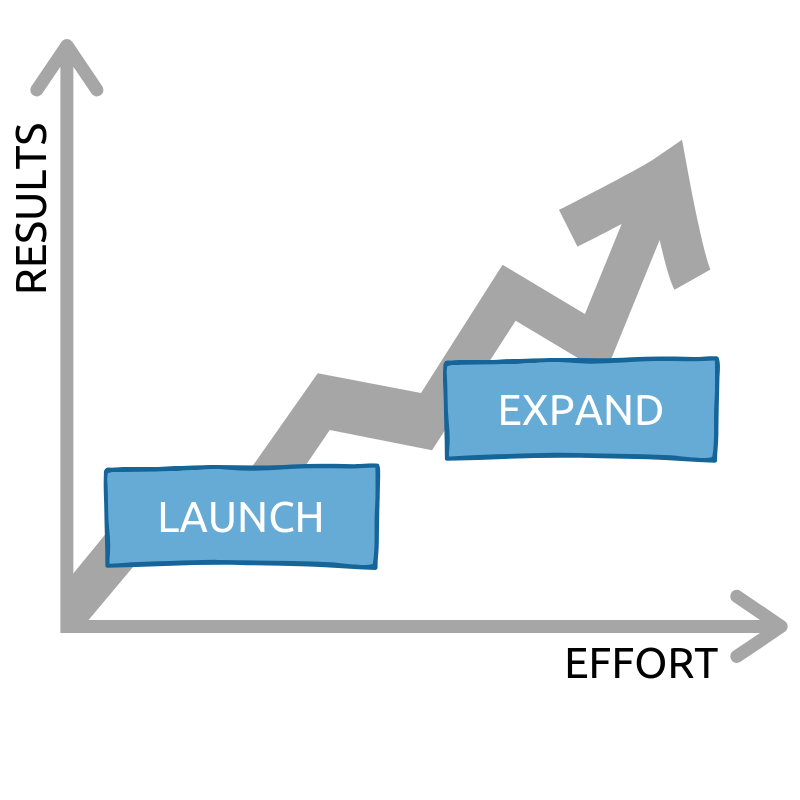
If you were to relate this to your small business, it could be simplified as two stages of growth: Launch and Expand.
Launch: get a business idea and launch it.
Expand: do more and grow.
Simple enough but this version of success rarely happens.
A more likely growth chart is that your results go up as well as down over the course of the year, as seen in the figure above. This is often called the roller coaster, giving you periods of feast and famine throughout the year.
You launch your business idea, then try to grow in Expand stage, but you run out time, energy or resources, which means your results go down. You only need to go through a few of these roller coaster loops to feel burnt out. I often refer to this as ‘launch fatigue’ as you don’t have the energy to put yourself through yet another launch in order to grow your business.
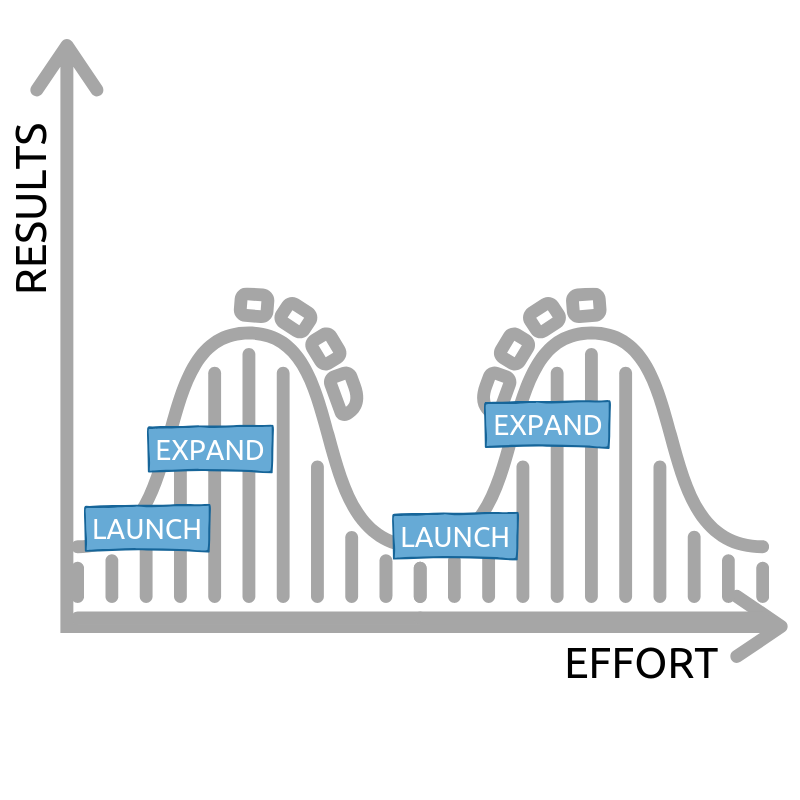
Whilst the natural instinct for many people – particularly those who have left a PAYE job and have got used to a steady paycheque – is to hope that their business will give them a constant and consistent income, for most small businesses this simply isn’t possible.
External influences in the economy, regulation changes and even fluctuations in the weather can mean you have little control over whether your business can give you this constant and consistent income. Add into the mix taking time out of your business for holidays or periods of illness, or nasty surprises such as your website getting hacked, a team member leaving you suddenly, or a higher than expected tax bill, and this can mean your cashflow has regular highs and lows.
But what if this feast and famine, that we are all programmed to believe is bad, was actually cycles of feast and fallow?
As working harder isn’t an option any more, as you are finding out, what if you could feel comfortable with the ups and downs in your business, the same way that we adapt to the change in our seasons?
Here in the UK, we plant our fields in spring, watch the crops grow in the summer and harvest in the autumn. Winter may be the dormant month but Mother Nature still works away, preparing the ground for the next cycle of feast for the following year. Crops need to be rotated and fields left fallow between the crops, to allow the soil to replenish itself.
The only way to plant in a different season and get a consistent and constant harvest is to control the growing environment with heated greenhouses, artificial sunlight and plenty of fertilisers and nutrients. So rather than forcing your growth with artificial sunlight and fertiliser, could you follow your natural business growth cycles?
What if we stopped trying to control the natural rhythms of business and work in tune with these feast and fallow cycles?
The True Profit Growth Flow
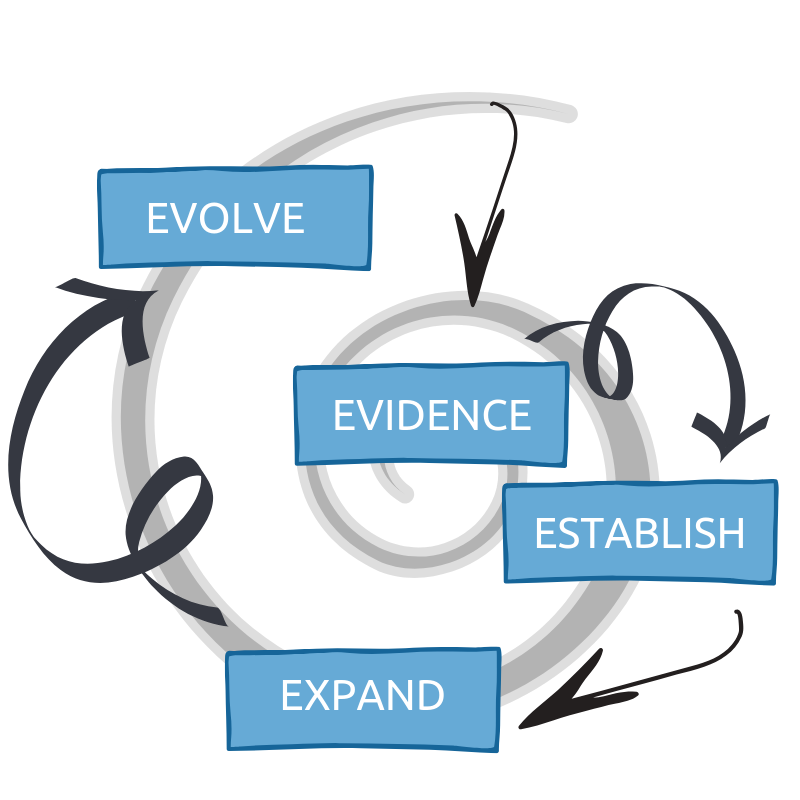
This is how I see growth working. There are four distinct phases of growth within a True Profit Business: evolve, evidence, establish and expand.
Evidence: getting proof that you have people who will buy what it is you offer by spending money with you.
Establish: getting feedback, building credibility and developing your business offer so you understand the results your clients get.
Expand: once you’ve proved that what you offer works, you can then start expanding your marketing systems, processes and team to build on your initial success.
Evolve: at some point, your systems and processes will stop working as well, as external factors change and your marketplace evolves. Which means that you have to evolve, too.
The new approach or idea you decide to take forward then drops back down into the Evidence phase again for you to find proof of concept. And so the Growth Flow continues back around.
You will notice there are no straight lines; the journey between each of these phases take you forwards, sideways and sometimes backwards before going forwards again. There’s no certainty of going from A to B to C to D. It’s more of a journey from A to B and then ‘Oh, shit, we need to go straight to G’ and then back to D before deciding to get C sorted before you go any further.
Through my research in writing my book, True Profit Business, and the work I’ve done with my clients over the past few years, I have seen this Growth Flow happen at all levels. It applies to your overall business journey across five to seven years, and it also applies to the specific lifecycle of your products and marketing campaigns. If you’ve been trying to take the approach of Launch and Expand, shown on the previous business growth chart in Figure 4, what you’ve essentially been doing is trying to go straight to phase three or four; Expand and Evolve.
If your own growth journey hasn’t been going as well as you have hoped, I hope that this gives you the reassurance that you haven’t failed. You are simply trying to navigate the ebbs and flows of the True Profit Growth Flow.
Over the coming weeks, I shall be sharing more about True Profit Business as my new book, True Profit Business, is published this September. In the meanwhile, I’d love to know what insights you have this article so do comment below and share your thoughts on what profit really means to you.
Thank you for reading. Until next time, do less, be more, play bigger.

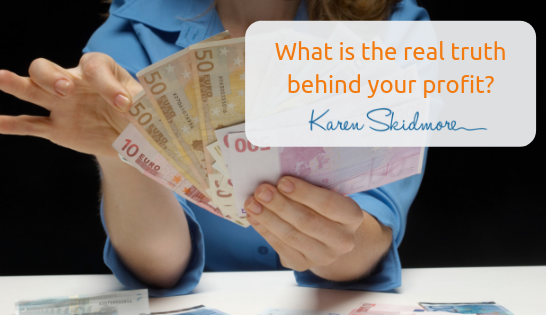
by Karen Skidmore | 05,19 | Marketing Articles, True Profit
For many of you who decide to start up a business, it isn’t the money that necessarily drives you above all else. However, making sales is a critical component to having a successful business. Without someone buying what it is you are selling, you have no business. Even a charity or not-for-profit organisation has to have an income to exist to do its work.
There’s often a lot of emotional baggage and over-thinking tied up with the process of sales and marketing, especially when money may not appear to be the primary driver. Feelings, beliefs, and thoughts about money and profit often create strong emotions and thinking around what you believe you are worth, the prices you charge and your ability to go out and sell.
You will have your own stories about what profit means to you.
Profiting can be viewed as a “bad” thing to do in business for a lot of people. I have heard many stories over the years from my clients about money; about how they base their behaviour on beliefs such as “I need to add more bonuses and get everything right before I put my offer out there”, “my clients wouldn’t pay those kinds of prices” or “I want my prices to be low enough for anyone to say yes”.
When you focus hard at making sales
The times that I have focused hard on making sales have been the unhappiest and most stressful months of running my business. I remember one period in particular when I decided to work with a sales mentor because I was frustrated with my inability to make enough money. I had convinced myself (and he had convinced me, too!) that he had the sales formula that would solve all my problems in just six weeks. He taught me a sales strategy that I now refer to as FOOB (F*%! Off Or Buy). The selling process meant that the offer I made on a call with a prospect was only available if the person decided to buy there and then. If they wanted to go away and think about it, that was OK but they wouldn’t get the special price I was offering to them. I was being taught to sell scarcity in a high-pressure sales environment so that I could make my sales targets.
I made my targets and I filled my programme, so you could say it worked. But I was miserable making my sales this way. It felt pressurised, the process didn’t align with my values and I soon decided to stop working with this particular mentor.
Each time I have found myself rising to the pressure of having to make money, it has rarely worked. Even when I have met my sales targets in this driven way, I didn’t seem to be any happier overall. My sales achievements often pushed me to up my game and increase my next month’s targets, I didn’t take the time to celebrate my successes and just raced on to the next idea or project. All this contributed to my burnout.
When you focus hard at doing anything but making sales
On the other end of the scale, there have been times that I have done anything but do the work to make the sales. When I first started up my business, I often used the phrase “I’m not doing this for the money”. I had stories going on in head such as “I’m just a mum who works from home” and “I need people to like me before they buy from me”. I was pretending to myself that money wasn’t important and these stories held me back. I felt incredibly uncomfortable when quoting my prices. I just hoped that my emails and blog posts would do the selling for me, rather than pick up the phone and speak to people directly (which frankly is still the simplest and easiest way to make sales today).
This would also happen during the times I was burning out; being knackered and brain fogged meant that my fears and doubts would have me spending my time re-writing my sales pages, creating pretty graphics, writing email autoresponders and posting updates on my social feeds. That’s all I felt I was capable of so I found myself busy for the sake of being busy because I didn’t have the energy to plan long term or think strategically about my business.
So when you focus hard to make sales, you are in danger of working against your values or lose sight of your purpose that can mean, over time, you burn out in the process. On the other end of the scale, if you aren’t connected with your purpose or your money stories are triggering your fears and doubts, your business has the danger of being nothing more than an expensive hobby.
What are you do?
Do we really have to sacrifice our creativity and purpose in order to make a profit?
What I have come to know now is that for you to fulfill your greatest potential and play your bigger game, your business needs to fuel three things: your creativity, your purpose and your financial goals. This is not an “either-or” choice you have to make. You can have a business that fulfills your purpose, allows you to have fun as well as make good money in the process.
A 6-figure business with a turnover of £250,000 may sound impressive, but when you see the business owner burnt out, unable to feel fulfilled or even pay themselves a decent income because their costs are so high, the True Profit of this business is low.
A business with half this turnover, but with the business owner working in flow and having decided that a £65,000 annual income is more than enough to give them what they want from life, the True Profit of the business may be considered high.
Everyone will have their own, unique True Profit figure and it’s important to recognise this. We often judge other people’s businesses from what we see externally; the number of people in the room at a conference or how many likes or comments they get on their Facebook posts. And then we use these judgments to benchmark our own success. But the external numbers only tell one part of the story.
Profit
Let’s dive into the topic of profit in more detail. If you look up the definition of profit, this is what you’ll find:
“The monetary surplus left to a producer or employer after deducting wages, rent, cost of raw materials, etc”
Now, I don’t know about you, but that definition is not terribly inspiring to me. When laid out like this, it’s easy to think that profit is best left for your accountant to sort out at the end of each year. Having a “monetary surplus” is hardly inspirational.
Even though I recognise the fact that making money is important, I’ve never been particularly motivated by numbers on a spreadsheet. In my early years, knowing what my profit was week in week out was never high on my agenda. I knew what my sales were (turnover) but never really bothered by what my “monetary surplus” was. They were even times where I would totally disregard the financial aspect of my business which, not surprisingly, did lead to the detriment of how much money I really did make. My sales may have been good but what this translated into profit and my personal income has been demotivating at times.
What does the word profit really mean?
A business like mine and yours is not just something we do; it’s not a job that we get hired for but a representation of who we are. No matter what you sell, you have so much of you wrapped up in it (your expertise, talents and intellectual property). This can make it hard to separate the pragmatic, monetary side of worth, with the worth that’s wrapped up so tightly in your heart, body, and soul.
This is why it’s interesting to look at the origins of the word profit because it has a completely different meaning to what we think of profit today. Go back to 1300 and the word profit comes from the old French “prufit, porfit”, meaning “benefit advantage”. If we go further back, the word profit comes from the Latin word “proficere”, which means “accomplish, make progress, be useful, do good, have success.”
Our modern-day economy has seemingly sucked the life-force out of the word. Profit is no longer associated with accomplishment and commitment to do good. The doingness of our business culture has morphed the word “profit” to give us a different version of success; a version that makes us feel we are never enough.
It’s time to change this. You, and all our micro-business and small business communities across the globe, have a huge combined economic power, as well as the ability to make our own choices in how we decide to grow our business, which in turn can change the way business impacts our planet and how we treat each other as human beings. Profit can once again mean that business is here to make progress, to be useful and does good.
That’s my bigger vision and my driving purpose for my business and the work that I do. But with as with most bigger visions, a mission such as this grows with one business at a time. So, let’s start with your business. Let’s dive into how you can bring these principles of True Profit Business into your business.
A new (and better!) way of doing business
The True Profit Business Model
We’ve established that financial profit is important; let’s not pretend otherwise. Without money flowing into your business, money can’t flow out. It’s a necessary energy to create growth. But take into account the hours you work, the effort you put in, the sacrifices you make, the stress that your business causes you … how does that financial figure translate into your health, wellness, happiness, time and impact that you make?
I believe that when you figure out how, when and where you want to work, get clear on your strengths and values, and design the right marketing systems, revenue streams and business model that fuels you, that this is when a True Profit Business Model can give you freedom to create, have an impact, as well make you money.
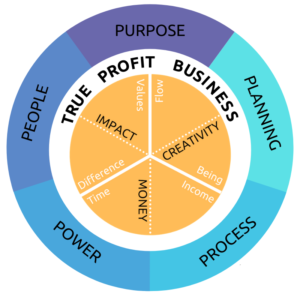
In the center of the True Profit Business Model are the three energies of money, creativity, and impact. It may not feel like it right now, but you have complete control over the choices of how each of these energies can work for you. Deciding on what these choices become your True Profit Compass, a navigation tool to help keep you centered on how your business works for you at each stage of your business growth journey. Your True Profit Compass evolves over time as you grow and evolve so it’s a tool you will want to review a few times a year and particularly before you create any next growth plan or make a decision to change the way you run your business.
Surrounding your True Profit Compass are the five True Profit Growth Pillars, which are there to support you at every stage of your growth. These pillars have to grow together because, as you can imagine, if even just one or two are not growing with you, you are going to have wobbly foundations for your business.
Over the coming weeks, I shall be sharing more about these five Growth Pillars and the True Profit Compass. My new book, True Profit Business, is coming out this September.
In the meanwhile, I’d love to know what insights you have this article so do comment below and share your thoughts on what profit really means to you.
Thank you for reading. Until next time, do less, be more, play bigger.



